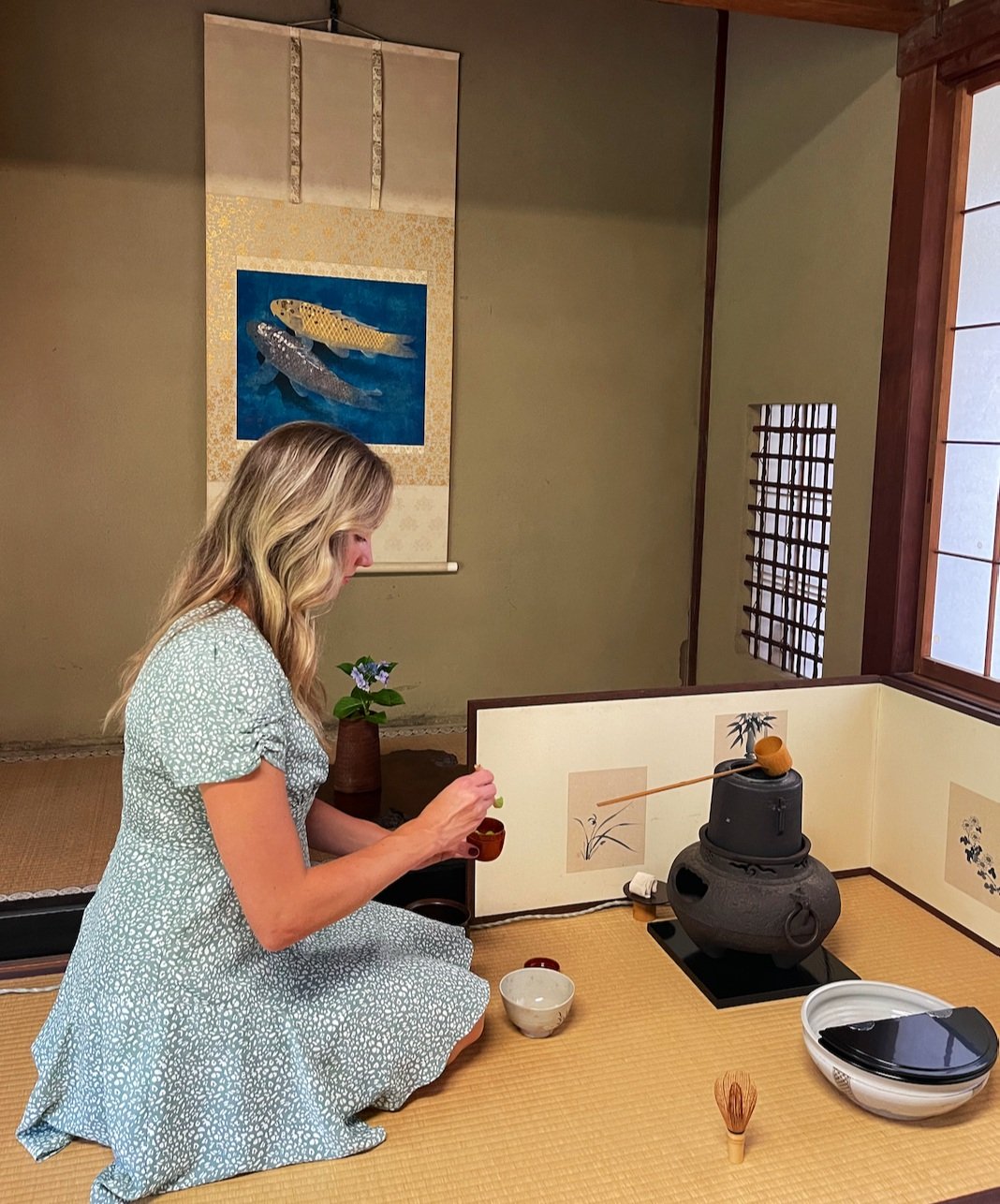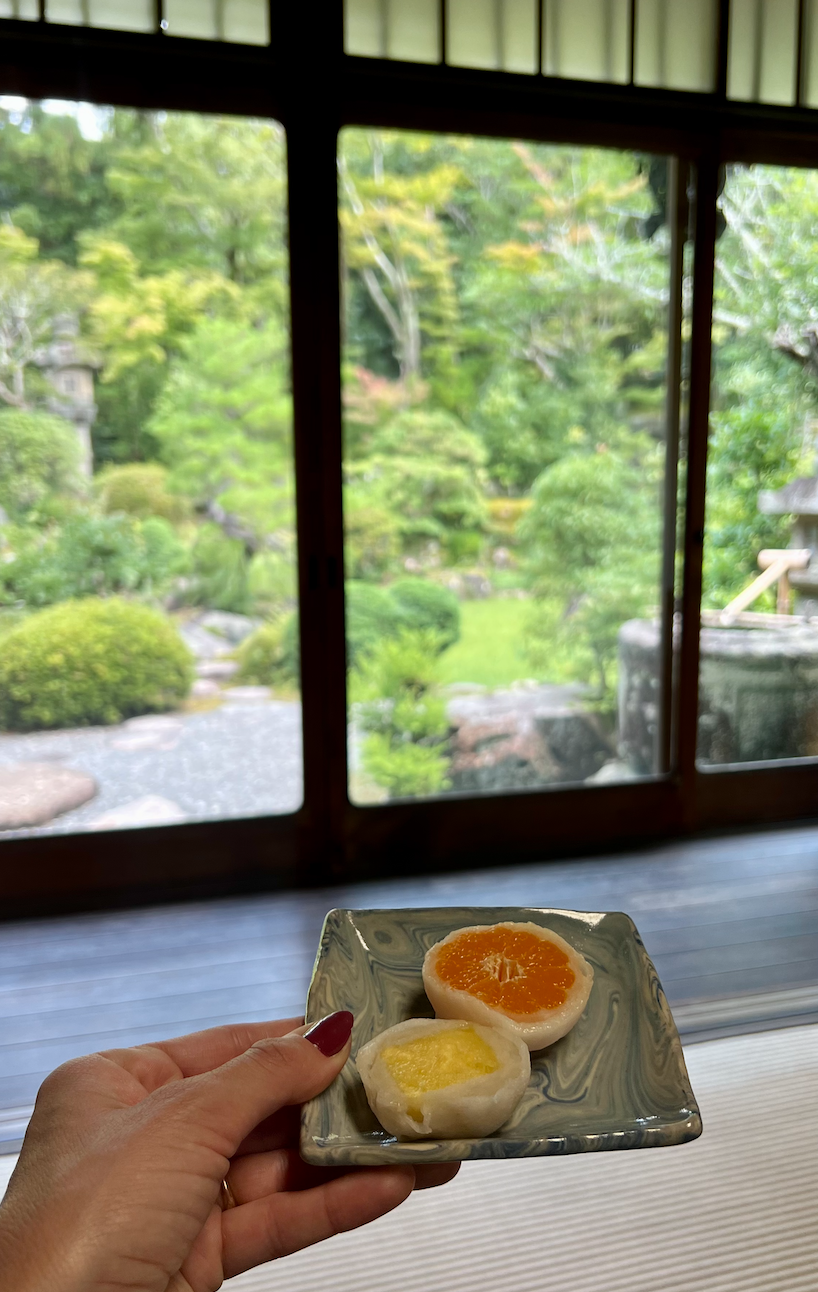The Japanese tea ceremony, known as “chanoyu” or “sado,” has profound cultural significance, embodying the essence of Japanese aesthetics, spirituality, and social etiquette. So when I visited Japan, experiencing an authentic, traditional Japanese tea ceremony in Kyoto was at the top of my very long Japan must-do list.
Why?
Because the tea ceremony goes way beyond just serving tea!
It’s a beautiful, artistic encapsulation of Japanese culture. And in my opinion, it’s one of the absolute best things to do in Japan if you’d like to get a better understanding of the culture and the people.
What is the purpose of the Japanese tea ceremony in Kyoto?
Originating in the 9th century, the roots of the Japanese tea ceremony’s are traced back to Zen Buddhism, where it became a practice to promote mindfulness and inner peace. It symbolizes harmony, respect, and hospitality, reflecting Japan’s collective consciousness. The careful choreography of every gesture, from preparing the tea to the way it’s served and consumed, reflects a deep respect for tradition and attention to detail.
My experience at the best Japanese tea ceremony in Kyoto
I’m always on the hunt for authentic travel experiences, and this was one of the best-of-the-best in Kyoto. I found it through Airbnb experiences– if you’ve been following me for a while, you know that this is my absolute favorite way to find local experiences when I’m traveling!
Here are all the details, including what exactly happens at the Japanese tea ceremony, how much it cost, what I loved about it, and how to book it!
What happens at a Japanese tea ceremony?
-
Watch the host execute the traditional tea ceremony
-
Enjoy matcha tea and traditional Japanese sweets in a historic and serene “minka,” or Japanese old residence
-
Learn all about the tea ceremony’s historical and cultural significance
-
Make your own matcha
-
Tour the zen garden for photos
When you arrive at the minka, you’ll see the beautiful tatami mat flooring, sliding doors, and wooden engawa verandas. This particular tea room in Kyoto has floor to ceiling windows that look out to a quiet Japanese garden. The ambiance of the tea room is serene, and it’s adorned with traditional calligraphy, art, and seasonal decorations. The host took the time to tell us about the specific seasonal significance of certain decorations in the tea room, which was really cool! We also were able to walk around the garden after the tea ceremony, and the host was sweet enough to show us some of her family’s oil-paper umbrellas (“wagasa”) 和傘.
Naomi, a lovely Japanese woman who explained everything to us in detail, hosts this tea ceremony. She carefully noted the the origination of the sweets, the tea, how to drink it, and the cultural and historical “why” behind each step of the tea ceremony.
The sweets in a Japanese tea ceremoney are called “wagashi.” They’re traditional Japanese desserts made of mochi, anko, and fruit. Wagashi are usually made of plant-based ingredients with seasonal fruit.
Kyoto can get really touristy, but this tea ceremony feels like a retreat. It’s based on the philosophy of Zen and the tea ceremony is in movement meditation. When I was watching Naomi execute the ceremony, it reminded me of dance– it was lyrical, smooth movements that were carefully timed and performed.
This experience cost $40 per person and you can book it here!
Other things to know about this Japanese tea ceremony Airbnb experience:
-
If you want to wear a traditional kimono, it costs 3000 yen. We didn’t do this because we had the opportunity to wear them at a ryokan later in our trip, but they are beautiful and if it’s your only chance to try one on, go for it!
-
What are the rules of a Japanese tea ceremony? There are a lot, from what side of the cup to sip from, jewelry that you can/can’t wear, when silence is required, and more. But don’t worry– the host walks you through exactly what to do and why!
If you’re looking for the top things to do in Kyoto, this is one that you don’t want to miss! Bonus: the Japanese residence where this is hosted is a 2 minute walk to Ninna-ji Temple (which I HIGHLY recommend doing while you’re in Kyoto). It’s also close to Arashiyama, Ryoanji Temple, Myoshinji Temple, and more.
I know what you’re thinking: “This is great for you, but how can I afford to travel more?” I’ve been there!
It’s easier than you think to travel on a tight budget if you have the right tools. From scoring cheap flights to saving on hotels, snag my FREE guide with ALL the best budget travel tips and tricks! ✈️



Your detailed narrative captures the essence of the tea ceremony beautifully. Maikoya in Kyoto offers a comparable experience, allowing participants to delve deep into this cherished tradition.